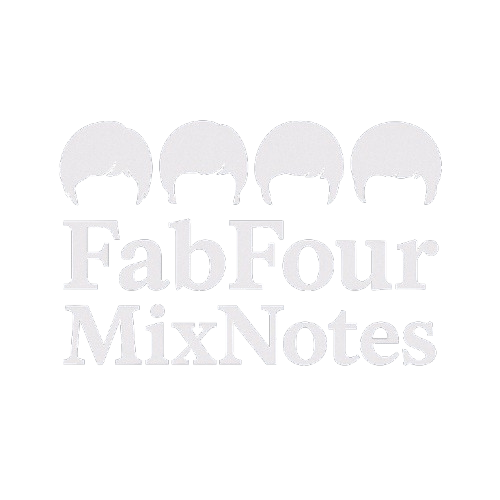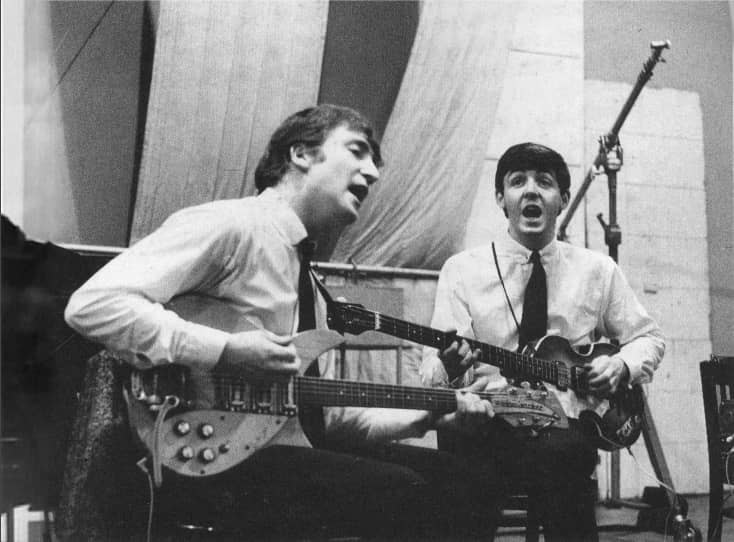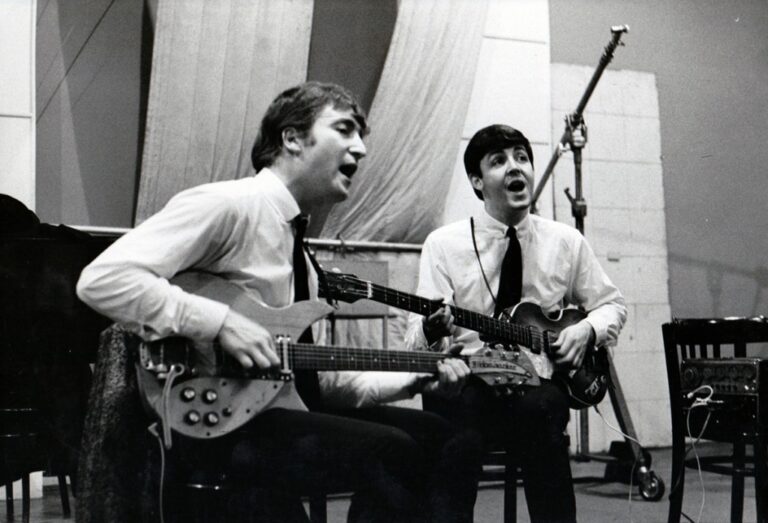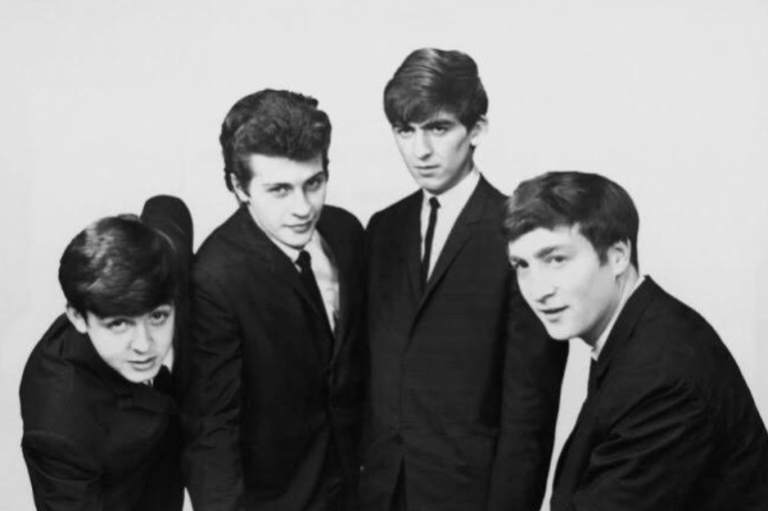Location and Time
EMI Studio 2
7:00 – 10:00pm
Songs
How Do You Do It?
Love Me Do
Personnel
John Lennon – guitar, vocals
Paul McCartney – bass, vocals
George Harrison – guitar
Ringo Starr – drummer
George Martin – Producer
Ron Richards – Assistant Producer
Norman Smith – Balance Engineer
Chris Neal – Assistant Engineer / Tape Operator
Instruments and Amplification
The following list is according to Jerry Hammack in The Beatles Recording Reference Manual: Volume 1, along with other sources listed below.
Format:
Year • Brand Model [Finish / Variant] — Type (Player) – Notes
Guitars
- 1957 Gretsch G6128 Duo Jet [Jet Black] – Electric Guitar (George Harrison)
- 1958 Rickenbacker 325 Capri with Bigsby B5 – Hallow-body electric guitar (John Lennon) 1
- 1961 Höfner 500/1 ‘Cavern’ [Sunburst] – Violin‑style Bass Guitar (Paul McCartney)
- 1962 Gretsch Chet Atkins Country Gentleman [Walnut] – Hallow-body Electric Guitar (George Harrison) 2
- Often alternated with his 1957 Duo Jet during late‑1962 sessions. It is disputed which guitar he had during this session.
Guitar Amplifiers
- 1960 Fender Deluxe ‘Narrow Panel’ 5E3 [Tweed] – 5 W Guitar Amplifier (John Lennon) 3
- c. 1960 Gibson GA-40T Les Paul, 16 W Electric Guitar Amplifier with Tremolo (George Harrison)
- 1962 JMI Vox AC30/6 Twin – 30 W Guitar Amplifier (John Lennon, George Harrison)
- Leak ‘Point One’ Preamplifier – Valve Hi-Fi Preamplifier (Paul McCartney) 4
- Leak TL/12 Plus Power Amp + Tannoy 15″ Dual‑Concentric Cabinet — 12 W Bass Amplifier (Paul McCartney) 5
- Temporarily pulled from the Echo Chamber One due to Paul’s noisy amp.
Percussion
- Premier Marine Pearl 58, Mahogany Duroplastic drums set (Ringo Starr)
- 20″ bass drum
- 12″ rack tom
- 16″ floor tom
- 14″ x 4″ Royal Ace snare
- Kurts cymbals *
- 20″ ride
- 18″ crash
- 14″ hi-hats
*Probable setup based on documented gear used during this period.
Other Instruments
- Hohner Chromonica 64 (Key of C) – Chromatic Harmonica (John Lennon)
*Based on known gear but not fully verified for this session.
Studio Gear
This is the standard setup used in the 1962 to 1964 era, unless noted.
The following list is according to Jerry Hammack in The Beatles Recording Reference Manual: Volume 1, along with other sources listed below.
Control Room
- REDD.37 valve console
- BTR-2 mono tape machine
- BTR-3 twin-track tape machine
- Altec 605A monitors
- EMI RS141 Leak TL, 25 Plus amplifier
- EMI RLS10
Outboard Signal Processors
- EMI RS114 Limiter
- EMI RS124 Altec Compressor
- EMI RS127 Presence Box
- EMI RS144 4-Way Mixer / Premix
- EMI RS92 Neumann Mic Equaliser
Effects
- Echo Chamber
- STEED send tape echo, echo delay
Microphones
- Neumann U 48 (vocals, electric guitar amplifiers, acoustic guitar, acoustic and electric keyboards)
- Neumann U 47/48 (vocals, electric guitar amplifiers, acoustic and electric keyboards)
- Neumann KM 54 (electric guitar amplifiers)
- STC 4038 (drum overhead)
- STC 4033-A (bass drum)
- STC 4033-A (bass guitar amplifier)
Session Notes
Mixing Techniques
- How Do You Do It? has Superimpositions with McCartney and Lennon on vocals.
- Love Me Do features Superimpositions with McCartney and Lennon on vocals, handclaps, and harmonica.
Additional Notes
- This was followed by their next studio appearance on 11 September 1962.
- This session marked The Beatles’ first official EMI recording date under contract. It was also Ringo Starr’s first session as the official drummer, although George Martin was not impressed with his playing and would bring in session drummer Andy White for the next attempt.
- They recorded two songs: the Martin-suggested How Do You Do It? (which the band disliked) and their original Love Me Do. The former was completed with a full backing track and vocals, though it would be shelved and given to Gerry and the Pacemakers instead.
- Superimposition techniques were used to add vocals and handclaps to Love Me Do, highlighting EMI’s early twin-track approach.
- Ringo played drums live but did not overdub percussion.
- The recording was deemed insufficient for release, setting up the better-known 11 September session a week later.
- This session represents an important turning point, where EMI began shaping the Beatles’ studio process, while the band pushed back creatively for more control.
- This version of Love Me Do with Ringo Starr on drums was chosen as The Beatles first single.
Fab Four Mix Notes
Superimposition: How Do You Do It?
Love Me Do / P.S. I Love You (Single Release Notes)
Media
Sources
Books
All the Songs: The Story Behind Every Beatles Release (Jean Michel Guedson, Philippe Margotin)
The Beatles Recording Reference Manual: Volume 1 (Jerry Hammack)
The Beatles Recording Techniques (Jerry Hammack)
The Complete Beatles Recording Sessions (Mark Lewisohn)
Here There Everywhere: My Life Recording the Beatles (Geoff Emerick)
Websites
- It is disputed if the Bigsby B5 vibrato was on Lennon’s Rickenbacker at this session. Lennon later modified his 325 by removing the Kauffman Vibrola for the Bigsby, along with installing the gold pick guard and Horner knobs.
All You Need to Know About John Lennon’s Favorite Rickenbacker Model (Guitar Player) ↩︎ - Instrument attribution disputed; Harrison was photographed with both the Duo Jet and Country Gentleman during 1962. ↩︎
- Loan gear supplied temporarily by EMI staff. ↩︎
- Loan gear supplied temporarily by EMI staff. ↩︎
- Loan gear supplied temporarily by EMI staff. ↩︎




